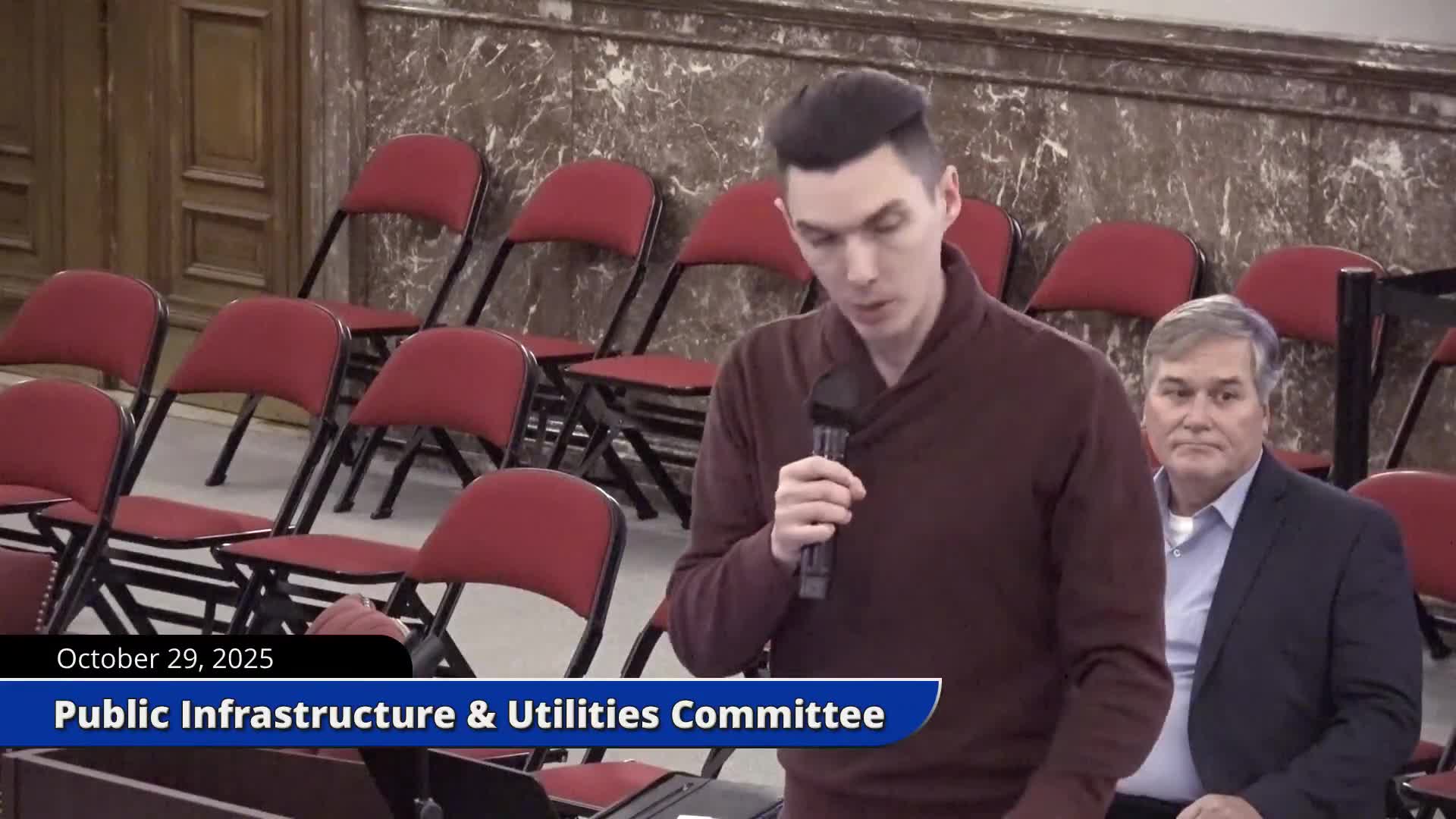Committee advances Board Bill 89 to fund Cass Avenue multimodal corridor, signal upgrades and Christie Greenway phase 2
October 30, 2025 | St. Louis City, St. Louis County, Missouri
This article was created by AI summarizing key points discussed. AI makes mistakes, so for full details and context, please refer to the video of the full meeting. Please report any errors so we can fix them. Report an error »

Board Bill 89, introduced by Alderman Michael Browning, would authorize city work and the allocation of federal funds for three capital transportation projects: the Cass Avenue multimodal corridor Phase 1, Traffic Management Enhancement Phase 9 along Skinker and McCausland (with a connector on Arsenal), and Christie Greenway Phase 2. The Public Infrastructure and Utilities Committee voted to send the ordinance out of committee with a due pass recommendation on Oct. 29.
John Kohler, from the Board of Public Service, told the committee the projects are federally funded and administered through the East West Gateway Council of Governments. He said the Cass Avenue work covers about 1.25 miles from Elliott on the west to Tucker near I‑70 and will include lane reductions, new lighting and a dedicated shared‑use path on the north side, intended to provide multimodal connections to neighborhoods, schools and businesses along the corridor. “It'll connect from I‑seventy to, the Jefferson, which is right adjacent to the NGA,” Kohler said of the route’s role in meeting commitments tied to the NGA relocation to North City.
Kohler described Traffic Management Enhancement Phase 9 as a signal modernization project that will rebuild 21 traffic signals along Skinker and McCausland between Page and Canterbury and a segment on Arsenal; the project includes traffic cameras, fiber interconnection to the city’s transportation management center, and curb‑ramp upgrades at every signalized intersection. He said those interconnections will allow the city to optimize signal timing and reduce emissions associated with congestion. Christie Greenway Phase 2, Kohler said, is roughly one mile and will provide a raised, separated multi‑use path connecting Holly Hills to a recently built signal under an ARPA‑funded Kings Highway project.
Committee members asked for funding and timing details. Kohler said the projects were submitted competitively to East West Gateway under different federal funding programs (the Cass project under the Surface Transportation Program, the signal work under CMAQ (Congestion Mitigation and Air Quality), and Christie under the Transportation Alternatives Program). He described the usual federal/local split as roughly 80/20 and noted that local match can come from City Capital, ward capital, partner agencies such as Great Rivers Greenway or Greater St. Louis Inc., and in the Cass example from NGA bonds. Kohler also said the city is limited by regional caps on the share of available funding any single jurisdiction may receive in a given year.
On project schedules, Kohler described a federally funded project lifecycle the city has observed: from application (typically submitted in February) to construction completion often takes five to seven years on average, longer for large right‑of‑way or bridge projects.
The committee passed Board Bill 89 by roll call; the clerk recorded five aye votes and the item will proceed to the next legislative steps.
Details on funding allocations, exact local match amounts by project phase and construction schedules remain to be finalized in future fiscal notes and project agreements.
John Kohler, from the Board of Public Service, told the committee the projects are federally funded and administered through the East West Gateway Council of Governments. He said the Cass Avenue work covers about 1.25 miles from Elliott on the west to Tucker near I‑70 and will include lane reductions, new lighting and a dedicated shared‑use path on the north side, intended to provide multimodal connections to neighborhoods, schools and businesses along the corridor. “It'll connect from I‑seventy to, the Jefferson, which is right adjacent to the NGA,” Kohler said of the route’s role in meeting commitments tied to the NGA relocation to North City.
Kohler described Traffic Management Enhancement Phase 9 as a signal modernization project that will rebuild 21 traffic signals along Skinker and McCausland between Page and Canterbury and a segment on Arsenal; the project includes traffic cameras, fiber interconnection to the city’s transportation management center, and curb‑ramp upgrades at every signalized intersection. He said those interconnections will allow the city to optimize signal timing and reduce emissions associated with congestion. Christie Greenway Phase 2, Kohler said, is roughly one mile and will provide a raised, separated multi‑use path connecting Holly Hills to a recently built signal under an ARPA‑funded Kings Highway project.
Committee members asked for funding and timing details. Kohler said the projects were submitted competitively to East West Gateway under different federal funding programs (the Cass project under the Surface Transportation Program, the signal work under CMAQ (Congestion Mitigation and Air Quality), and Christie under the Transportation Alternatives Program). He described the usual federal/local split as roughly 80/20 and noted that local match can come from City Capital, ward capital, partner agencies such as Great Rivers Greenway or Greater St. Louis Inc., and in the Cass example from NGA bonds. Kohler also said the city is limited by regional caps on the share of available funding any single jurisdiction may receive in a given year.
On project schedules, Kohler described a federally funded project lifecycle the city has observed: from application (typically submitted in February) to construction completion often takes five to seven years on average, longer for large right‑of‑way or bridge projects.
The committee passed Board Bill 89 by roll call; the clerk recorded five aye votes and the item will proceed to the next legislative steps.
Details on funding allocations, exact local match amounts by project phase and construction schedules remain to be finalized in future fiscal notes and project agreements.
View full meeting
This article is based on a recent meeting—watch the full video and explore the complete transcript for deeper insights into the discussion.
View full meeting
